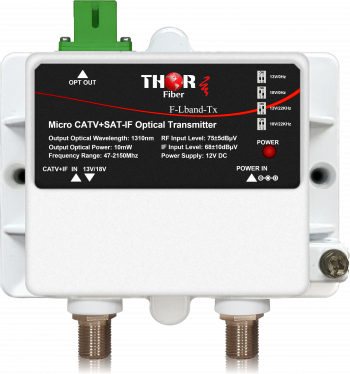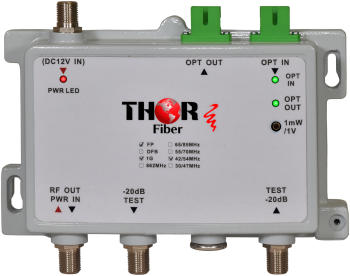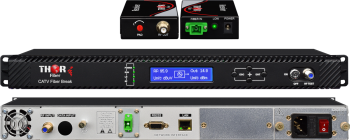RF to fiber media converters
The higher the frequency of the modulated electromagnetic wave, the more information can be stored on it. Optical frequencies are several orders of magnitude larger than radio, which means that the future belongs to optical fibers, and coaxial cables will be a rare addition. This will not change the fact that decent (Thor Broadcast) converters will always be needed. Read about RF to Fiber converters or check our equipment
Cable TV (CATV) - a telecommunications network that allows subscribers to offer a package of radio and television programs and a wide range of interactive multimedia services (i.e. Internet, telephone, VOD), implemented using hybrid fiber-coaxial (HFC) technology or collective antenna (older solution, often used in, for example, blocks of flats). Cable TVs use a bandwidth of ~ 50 to ~ 900 MHz for transmission. Each program takes 8 MHz (PAL D / K, D1 standard) & 6Mhz (QAM and ATSC in North America), so you can send up to 94 programs of TV stations via coaxial cable. The main task of cable television is to provide subscribers for a small price with a huge amount of modulated signals. Due to the gigantic density of transmitted information and the need to ensure its undisturbed flow over long distances, the main ducts are built on the basis of optical fibers and optical electronics, which is best suited for such purposes. Closer to end users, once again the price and technical capabilities make it necessary to convert the optical signal into much lower radio frequencies. All this causes that this branch of telecommunications is saturated with a large number of converters, both RF to fiber and fiber to RF, really necessary in this industry
The optical converter differs from a typical electronic converter that has a signal socket adapted to connect a fiber instead of a coaxial cable. This causes a significant increase in the converter's complications and prices. Nevertheless, a converter with fiber optic output has many advantages - thanks to the use of such a solution, it is possible to send a signal over a long distance. The signal attenuation in the optical fiber is very small, thanks to which the fiber optic cable can be several hundred meters long and even many kilometers long without the need for amplifiers or regenerators. The signal from such a converter can be spread over long distances both vertically (very tall buildings) and horizontally (in buildings with many flats and housing estates). In addition, fiber-optic transmission is insensitive to electromagnetic interference. The fact of separating the galvanic converter from the rest of the installation is also significant. Thanks to this, the number of surge protection and lightning protection of the distribution system is significantly reduced. The signals in the optical converter do not have to undergo additional processing, demodulation or decoding. With its application, it is possible to build extensive satellite distribution networks that meet the criteria of a group antenna. To supply them with electricity, an additional, traditional cable with wires must be connected.
Thor Fiber specializes in RF over Fiber hardware; well known for CATV and Satellite fiber distributions, Thor also provides many options for EDFA's, receivers, and easy to use, plug and play kits will allow almost anyone to utilize this equipment.
1

1550nm RF Over Fiber Tx 45-870 MHz 2 -16 mW
Internally modulated 2-8 mW Fiber Optic RF CATV Analog or Digital QAM ATSC Transmitter for Television Carrier signals or any other RF in the 45-870 MHz band. 1550nm Optics for C-Band comparability with EDFA Optical Amplifier systems.
2

L-BAND over Fiber Tx+Rx Basic 1 Ch Kit
L-Band RF satellite signal extender over fiber optic cable transport system. multiple L-band fiber optic transport up to 80 Km. Can also provide LNB power at various voltages.
3

S-BAND over Fiber
S-Band RF over fiber optic cable transport system. Can be customized for transport distances of up to 150 Km. Can also provide LNB power at various voltages.
4

Ku-BAND over Fiber
Ku-Band RF over fiber optic cable transport system. Can be customized for transport distances of up to 150 Km. Can also provide LNB power at various voltages.
5

K-BAND over Fiber
K-Band RF over fiber optic cable transport system. Can be customized for transport distances of up to 150 Km. Can also provide LNB power at various voltages.
6

Cellular RF Signals Over Fiber
We carry solutions for GSM over fiber as well as other Cellular signals over fiber. We can customize the optics for transport distances of up to 150 Km.
DAS, WiMax, Satcom, LTE
7

1-4 GPS over Fiber
This unit is for transporting GPS RF carrier signals over fiber for transport indoors or to non line of sight locations. Perfect for hangars, ships, or buildings. Provides a transparent and secure RF connection between your GPS antenna and receiver for distances from 100 ft to 20Km The GPS signal the frequency standard can generate very precise timing or sinewave outputs that are used in a variety of applications.
8

10

RF Fiber Break - optical RF COAX isolation solution
Low Cost RF Fiber Break system for high security RF feeds. For short distance transport over fiber and for RF security to prevent any RF leaks. Prevents Coax from being used to transmit data in the return direction, using a Fiber Break Kit eliminates any possibility of your copper transmission returning on RF. Kit includes Transmitter, Fiber Jumper, and mini-Receiver.
11

2 mW CATV RF Over Fiber Tx 45-870 MHz
2 mW Fiber Optic RF Transmitter for Television Carrier signals or any other RF in the 45-870 MHz band. Transmits full band signals with linear response.
12

4 mW CATV RF Over Fiber Tx 45-870 MHz
4 mW Fiber Optic RF Transmitter for Television Carrier signals or any other RF in the 45-870 MHz band. Transmits full band signals with linear response.
13

8 mW CATV RF Over Fiber Tx 45-870 MHz
8 mW Fiber Optic RF Transmitter for Television Carrier signals or any other RF in the 45-870 MHz band. Transmits full band signals with linear response.
14

16 mW CATV RF Over Fiber Tx 45-870 MHz
16 mW Fiber Optic RF Transmitter for Television Carrier signals or any other RF in the 45-870 MHz band. Transmits full band signals with linear response.
15

32 mW CATV RF Over Fiber Tx 45-870 MHz
32 mW Fiber Optic RF Transmitter for Television Carrier signals or any other RF in the 45-870 MHz band. 1550nm Optics for C-Band comparability with EDFA Optical Amplifier systems.

 ES
ES















